
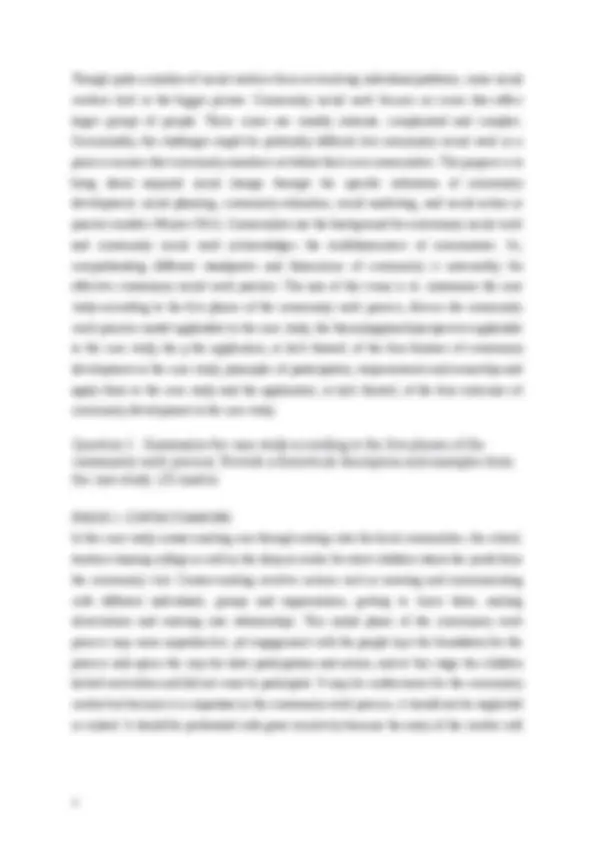

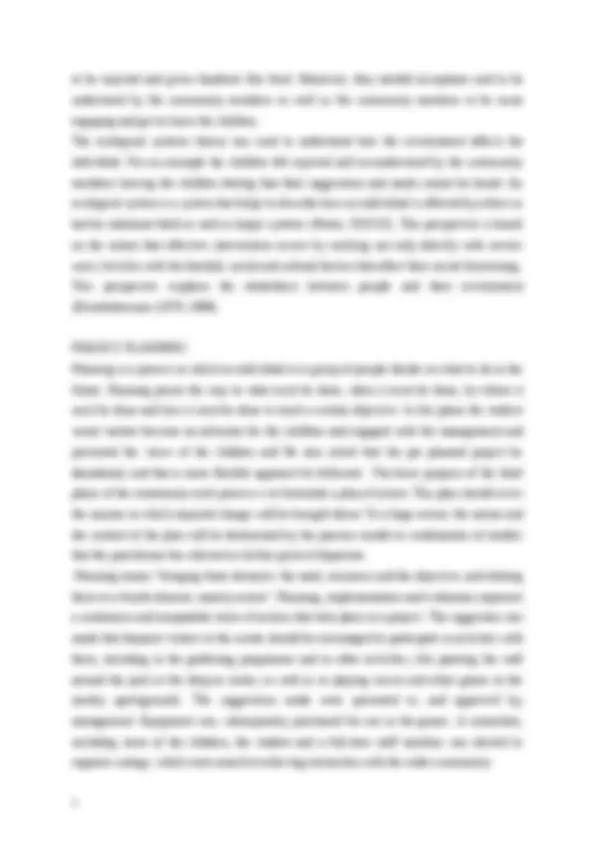

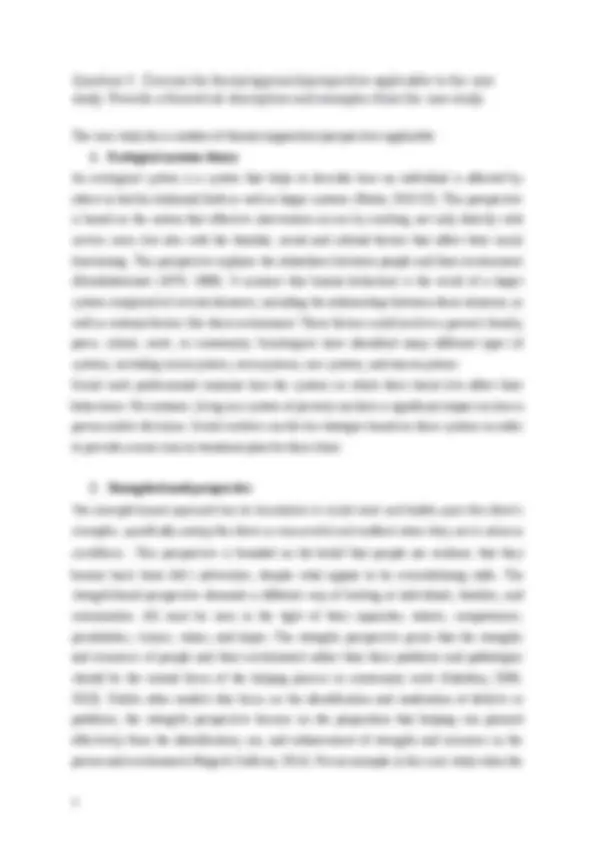
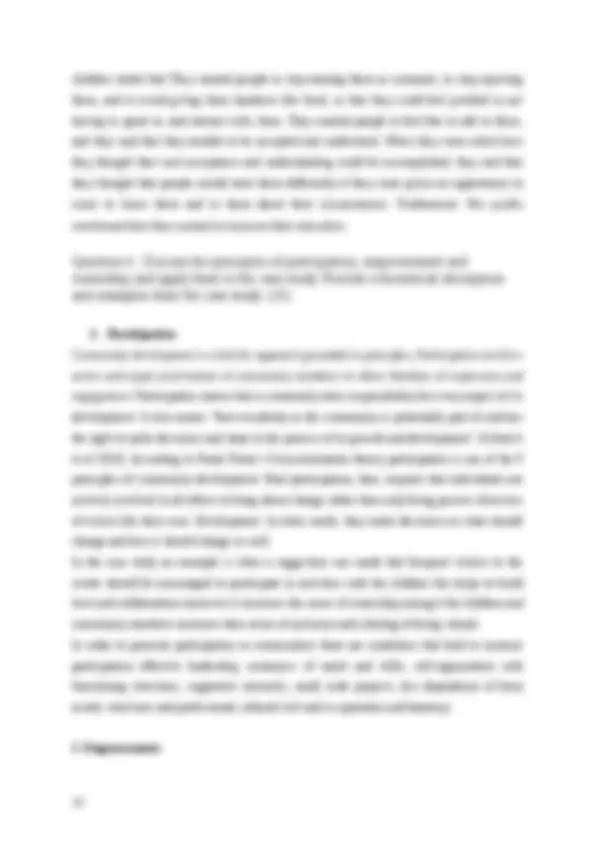
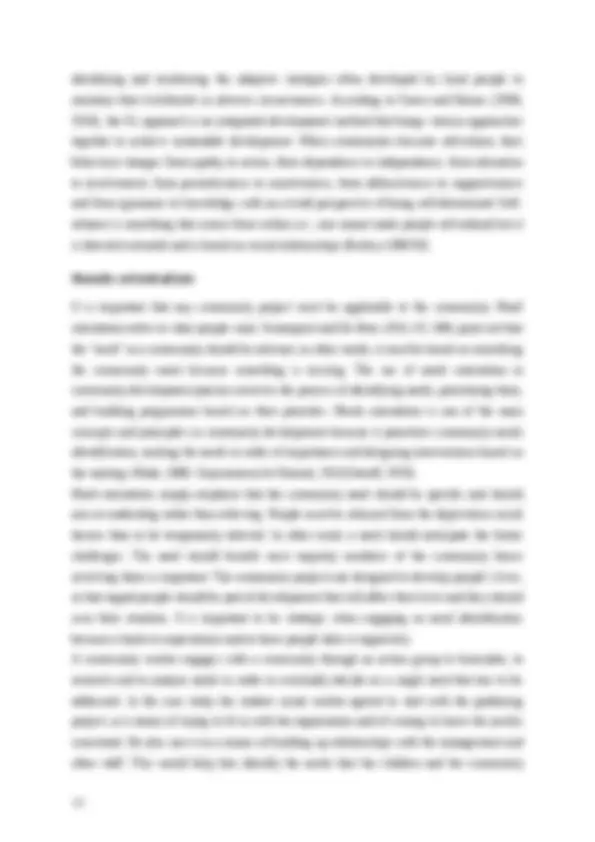
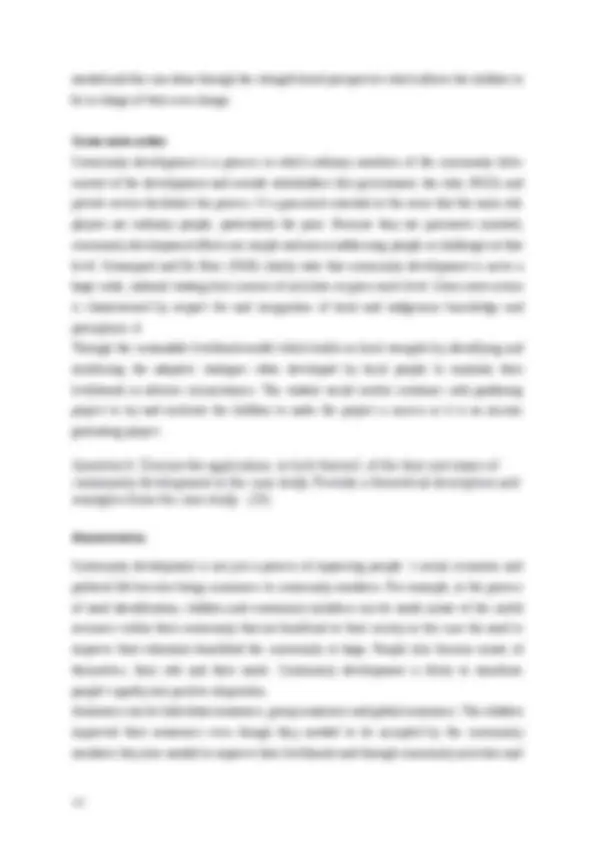
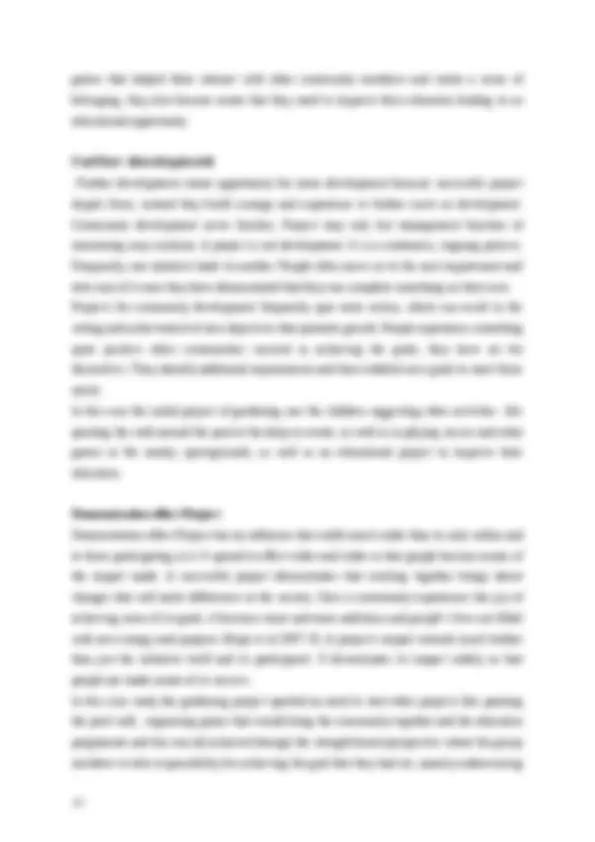



Study with the several resources on Docsity

Earn points by helping other students or get them with a premium plan


Prepare for your exams
Study with the several resources on Docsity

Earn points to download
Earn points by helping other students or get them with a premium plan
Community
Ask the community for help and clear up your study doubts
Discover the best universities in your country according to Docsity users
Free resources
Download our free guides on studying techniques, anxiety management strategies, and thesis advice from Docsity tutors
BSW3703_Assignment_2 - Social Work Practice (2023) UNISA
Typology: Assignments
1 / 18

This page cannot be seen from the preview
Don't miss anything!











`
raise expectations in the community – the greater the deprivation of the people, the greater the expectations. Making contact is a two-way process. The community gets to know the worker and the worker gets to know the people, their environment, and in the process the people become more aware of themselves, their needs and their resources. A strengths- and asset-based approach was followed by the student worker. The worker can achieve this by going to the people where they are (not expecting them to come to the worker) and spending time with them, learning from them and becoming aware of what they know and what they are experiencing. The developmental or social development approach entails a process of planned social change designed to promote, sustain and improve the well-being of the population as a whole for example gardening empowered the street children by providing them with necessary skills (gardening skills and resources so they could sell the proceeds to the community at large and generate income. This approach goes hand in hand with a dynamic process of economic empowerment (Midgley, 1995; 2001). This approach encompasses developing programs that empower people to be involved in meeting their needs. PHASE 2: NEEDS AND RESOURCE ASSESSMENT At this stage management identified the needs and resources for the children being skills development and income generation through gardening project which would generate income for the children. The basic purpose of the second step of the community work process is to explore and assess or analyse the previously identified issues or unfulfilled needs and unutilised potential in greater detail. Therefore, needs identification is a prerequisite for action – it is the first step that must be taken before a project commences. This need or perception of a need must be heartfelt among the people who must participate in a project and the student social identified that the children were not interested in the gardening project, therefore the student worker agreed to start with the project as a means of trying to fit in with the organisation and of coming to know the youths concerned, and their needs, as well as a means of building up relationships with the management and other staff. People are not going to rally together around needs that have been identified by some expert and that they find difficult to give concrete form. The children felt the community judged them and they needed acceptance and support from the community members, the children only participated in the programme out of fear and felt their suggestions would be unheard. The Children wanted to be listened to, they did not want
to be rejected and given handouts like food. Moreover, they needed acceptance and to be understood by the community members as well as the community members to be more engaging and get to know the children. The ecological systems theory was used to understand how the environment affects the individual. For an example the children felt rejected and misunderstood by the community members leaving the children feeling that their suggestions and needs cannot be heard. An ecological system is a system that helps to describe how an individual is affected by others in her/his relational field as well as larger systems (Reiter, 2015:52). This perspective is based on the notion that effective intervention occurs by working not only directly with service users, but also with the familial, social and cultural factors that affect their social functioning. This perspective explains the relatedness between people and their environment (Bronfenbrenner (1979; 1989). PHASE 3: PLANNING Planning is a process in which an individual or a group of people decide on what to do in the future. Planning points the way to what must be done, when it must be done, by whom it must be done and how it must be done to reach a certain objective. In this phase the student social worker become an advocate for the children and engaged with the management and presented the views of the children and He also asked that the pre planned project be abandoned, and that a more flexible approach be followed. The basic purpose of the third phase of the community work process is to formulate a plan of action. This plan should cover the manner in which required change will be brought about. To a large extent, the nature and the content of the plan will be determined by the practice model or combination of models that the practitioner has selected as his/her point of departure. Planning means "bringing three elements: the need, resources and the objective, and relating them to a fourth element, namely action”. Planning, implementation and evaluation represent a continuous and inseparable series of actions that take place in a project. The suggestion was made that frequent visitors to the centre should be encouraged to participate in activities with them, including in the gardening programme and in other activities, like painting the wall around the pool at the drop-in centre, as well as in playing soccer and other games at the nearby sportsgrounds. The suggestions made were presented to, and approved by, management. Equipment was, subsequently, purchased for use in the games. A committee, including some of the children, the student and a full-time staff member, was elected to organise outings, which were aimed at achieving interaction with the wider community.
rather than their problems and pathologies should be the central focus of the helping process in community work (Saleebey, 2006; 2013). Unlike other models that focus on the identification and eradication of deficits or problems, the strengths perspective focuses on the proposition that helping can proceed effectively from the identification, use, and enhancement of strengths and resources in the person and environment (Rapp & Sullivan, 2014). PHASE 5: MONITORING AND EVALUATION The final phase of the community work process involves evaluating the process and its results and, in certain circumstances, sustaining or maintaining change.At this stage The educational opportunities provided started well, but then some of the older boys, including some of the committee members, became reluctant to attend the classes concerned, and dropped out. it was discovered that, due to their illiteracy, the younger boys were teasing them. An arrangement was made for boys of the same age to be grouped together in a class, even if such a class were to have to cater for those of different educational levels.. We can assume that mistakes will be made and that the identification and analysis of those mistakes will help make future efforts more effective. Evaluation is an integral part of a project. It forms part of the survey – the reality or the situation is evaluated through the information obtained and the information is evaluated to ensure that it is legitimate and correct. Evaluation is also tied up with needs and resource identification in that a fit between needs and resources is sought. It is necessary during implementation since the action group's ability to operationalise the plan has to be assessed (Swanepoel & De Beer, 2016:268). Swanepoel and De Beer (2016:268) refer to three types of evaluation relevant to community development, namely, assessment, monitoring and final evaluation. It is clear that a large portion of evaluation takes place throughout the life of a project and only a small part has to do with a final, after-the-fact evaluation. The larger, continuous part of evaluation, called monitoring, involves keeping one's finger on the pulse of a project.
Community education The community work practice model applicable to this case study is the Community education model which aims to eliminate ignorance by empowering individuals, groups and
communities with the knowledge, attitude and skills that they require to take control of their lives and to contribute effectively to the environment in which they live. Making contact is a two-way process. The community gets to know the worker and the worker gets to know the people, their environment, and in the process the people become more aware of themselves, their needs and their resources. If a strengths- and asset-based approach is followed, the third objective is about analysing opportunities (Skhosana and Morake.2019:151-152).For example in this case study teaching and empowering the children with gardening skills, for them to be able to earn money from selling their produce, this is theoretically underpinned by the strength based perspective which denotes that reminds us that every person, family, group and community holds the key to their own transformation and meaningful change process. The real challenge is and always has been whether we are willing to fully embrace this way of approaching or working with people. If we do, then the change needs to start with us, not with those we serve. Embracing a strengthbased approach involves a different way of thinking about people and of interpreting their patterns of coping with life challenges. With a strength based mindset, one asks different questions and communicates in ways that invites a curious exploration based upon a clear set of values and attitudes for an example the children suggested that frequent visitors to the centre should be encouraged to participate in activities with them, including in the gardening programme and in other activities, like painting the wall around the pool at the drop-in centre, as well as in playing soccer and other games at the nearby sportsgrounds. Moreover another example is that the youths themselves then started to organise the games and activities concerned. Doing so encouraged the group members to take responsibility for achieving the goal that they had set, namely endeavouring to ensure that others would come to understand them. The effectiveness of a community’s social functioning is primarily determined by its members’ social attitudes and associated behaviour and by the fact that these can be changed by employing the same principles used in selling commercial goods and services (Weyers.2011: 16 & 251). However, the strengths-based approach is not a model for practice. It is an approach to practice based upon a philosophy and depends on values and attitudes. It is the strength-based values and attitudes that are the primary drivers of the intervention process and outcomes - not skills and knowledge. Skills and knowledge are drawn upon as resources to serve the principles that enable individuals to better understand their strengths and capacities to determine their own potential and path towards success
children stated that They wanted people to stop treating them as criminals, to stop rejecting them, and to avoid giving them handouts like food, so that they could feel justified in not having to speak to, and interact with, them. They wanted people to feel free to talk to them, and they said that they needed to be accepted and understood. When they were asked how they thought that such acceptance and understanding could be accomplished, they said that they thought that people would treat them differently if they were given an opportunity to come to know them and to learn about their circumstances. Furthermore The youths mentioned that they wanted to improve their education.
1. Participation Community development is a holistic approach grounded in principles, Participation involves active and equal involvement of community members to allow freedom of expression and engagement. Participation means that a community takes responsibility for every aspect of its development. It also means “that everybody in the community is potentially part of and has the right to make decisions and share in the process of its growth and development” (Schenck et al 2010). According to Paulo Freire’s Conscientization theory participation is one of the 5 principles of community development. Real participation, then, requires that individuals are actively involved in all efforts to bring about change rather than only being passive observers of events like their own. Development. In other words, they make decisions on what should change and how it should change as well. In the case study an example is when a suggestion was made that frequent visitors to the centre should be encouraged to participate in activities with the children this helps to build trust and collaboration moreover it increases the sense of ownership amongst the children and community members increases their sense of inclusion and a feeling of being valued. In order to promote participation in communities there are conditions that lead to increase participation effective leadership, awareness of needs and skills, self-organisation with functioning structures, supportive networks, small scale projects, less dependence of beau acratic structures and professional, reduced risk and co-operation and harmony. 2. Empowerment
According to Chambers (1993), empowerment enables the poor and powerless to take more control over their own lives. Empowerment is related to the strengths-based perspective and is based on a process of change and transformation. The guiding principle of empowerment is that mobilisation must be aimed at giving people the power or the right to make decisions. that mobilization must be directed toward granting individuals the authority or freedom to make decisions., it involves skills development and decision making. An example of empowerment in the case study is that gardening empowers the children with skills and knowledge and are able to sell their proceeds to the community at large moreover acquiring more education through the education lessons provided by the students from the educational college increases the children and community members academic status and are able to make informed decisions.
3. Ownership Ownership involves being in control, accepting responsibility (participation), and being able to respond to what is required (capable). The Social worker and the stakeholders are there to facilitate, support and assist the community members they don’t come in as expects and implement their own programmes but are rather guided by the community members according to their needs. Ownerships shifts its focus from creating the impression that what will be done will be the community worker’s project and not that of the community and this promotes Ownership and self-reliance (depending on the available resources) and the two are closely related. Ownership develops when the need a project attempts to meet is actually a need of the community and when the community developer works from the frame of reference of the community and not that of an external party. For an example the student social worker worked with the children on the gardening project and the student explained, however, that the purpose of his interaction with the children was to develop a project based on a common or shared need. The project should entail something that the youths wanted, and on which they had agreed, as doing so would be likely to motivate them.
identifying and reinforcing the adaptive strategies often developed by local people to maintain their livelihoods in adverse circumstances. According to Green and Haines (2008, 2016), the SL approach is an integrated development method that brings various approaches together to achieve sustainable development. When communities become self-reliant, their behaviour changes from apathy to action, from dependence to independence, from alienation to involvement, from powerlessness to assertiveness, from defensiveness to supportiveness and from ignorance to knowledge, with an overall perspective of being self-determined. Self- reliance is something that comes from within (i.e., one cannot make people self-reliant) but it is directed outwards and is based on social relationships (Burkey 1996:50). Needs orientation It is important that any community project must be applicable to the community. Need orientation refers to what people want. Swanepoel and De Beer (2011:42; 166) point out that the “need” in a community should be relevant, in other words, it must be based on something the community wants because something is missing. The use of needs orientation in community development practice involves the process of identifying needs, prioritizing them, and building programmes based on their priorities. Needs orientation is one of the main concepts and principles in community development because it prioritises community needs identification, ranking the needs in order of importance and designing interventions based on the ranking (Wade, 1989; Onyenemezu & Olumati, 2013;Sheriff, 2020). Need orientation simply emphasis that the community need should be specific and should aim at eradicating rather than relieving. People must be released from the deprivation social factors than to be temporarily relieved. In other word, a need should anticipate the future challenges. The need should benefit most majority members of the community hence involving them is important. The community projects are designed to develop people’s lives, in that regard people should be part of development that will affect their lives and they should own their situation. It is important to be strategic when engaging on need identification because it leads to expectations and at times people takes it negatively. A community worker engages with a community through an action group to formulate, to research and to analyse needs in order to eventually decide on a single need that has to be addressed. In the case study the student social worker agreed to start with the gardening project, as a means of trying to fit in with the organisation and of coming to know the youths concerned. He also saw it as a means of building up relationships with the management and other staff. This would help him identify the needs that the children and the community
needed and this was done through the strength based perspective which allows the children to be in charge of their own change. Grass-roots action Community development is a process in which ordinary members of the community takes control of the development and outside stakeholders like government, the elite, NGOs and private sectors facilitates the process. It is grassroots oriented in the sense that the main role players are ordinary people, particularly the poor. Because they are grassroots oriented, community development efforts are simple and aim at addressing people or challenges at that level. Swanepoel and De Beer (2016) clearly state that community development is never a large-scale, national strategy but consists of activities at grass-roots level. Grass-roots action is characterised by respect for and recognition of local and indigenous knowledge and perceptions. A Through the sustainable livelihood model which builds on local strengths by identifying and reinforcing the adaptive strategies often developed by local people to maintain their livelihoods in adverse circumstances. The student social worker continues with gardening project to try and motivate the children to make the project a success as it is an income generating project.
Awareness Community development is not just a process of improving people ‘s social, economic and political life but also brings awareness to community members. For example, in the process of need identification, children and community members can be made aware of the useful resources within their community that are beneficial to their society in this case the need to improve their education benefitted the community at large. People also become aware of themselves, their role and their needs. Community development is likely to transform people’s apathy into positive disposition. Awareness can be Individual awareness, group awareness and global awareness. The children improved their awareness even though they needed to be accepted by the community members they also needed to improve their livelihoods and through community activities and
to ensure that others would come to understand them. Their organisational responsibilities also provided a learning opportunity for them. Through trial and error, they learnt to take the initiative and to experiment with what resources they had available to them. Sustainability Sustainability relates to the well-being of people and means being able to support this well- being adequately for an extended period. Sustainability is therefore closely related to self- reliance. The change that development brings should be economically, socially, institutionally and environmentally sustainable (Chambers 2006:11). In development work, “sustainability” refers to three aspects of life that should be capable of continuing. 1.The natural environment,
To conclude The idea behind community development is simple: residents take collective action to generate solutions to common problems. There are stages in community development the contact making, needs and resources, planning, implementation and monitoring and evaluation. Educational community work practice model was applicable to the case. Ecological systems theory theories and strengths based theory were applicable to the case study. Theories, approaches and perspectives enhance the understanding of the interconnections between people and their environment. The approaches and practice models are not always clearly distinguished. Principles of social work are important for working with communities. The following are five features of community development (collective action, self-reliance, needs orientation, objective orientation, and grassroots action) and outcomes of community development (awareness, community development leads to further development, demonstration effect, community building and sustainability
Comminity Work , Theories, approaches and methods (BSW3703 Study Guide) R.Skosana and WL Morake, 2020. University of South Africa. Green, G., & Haines, A. (2008). Asset building and community development (2nd ed). Thousand Oaks, CA: Sage. Marx, J. D., Broussard, C. A., Hopper, F. A. & Worster, D. (2011). Social work and social welfare: an introduction. Boston: Allyn & Bacon. Rank, M. (2008). Poverty. Encyclopedia of Social Work (20th Ed.). (3) 387- Skosana RS and Morake WL. BSW3703.2019. Community Work: Theories, approaches and models. University of South Africa, Muckleneuk, Pretoria. Swanepoel H and de Beer F. 2006. (4th edition). Community development: Breaking the cycle of poverty. Cape Town, South Africa : Juta & Company Swanepoel H and de Beer F. 2011. ( 5th edition). Community development: Breaking the cycle of poverty. Cape Town, South Africa : Juta & Company Swanepoel, H. & De Beer, F., 2016, Community development: Breaking the cycle of poverty, 6th edn., Juta, Lansdowne, Cape Town, South Africa : Juta & Company. Weyers, ML. 2011. The theory and practice of community work: a Southern African perspective. 2nd edition. Potchefstroom: Keurkopie.